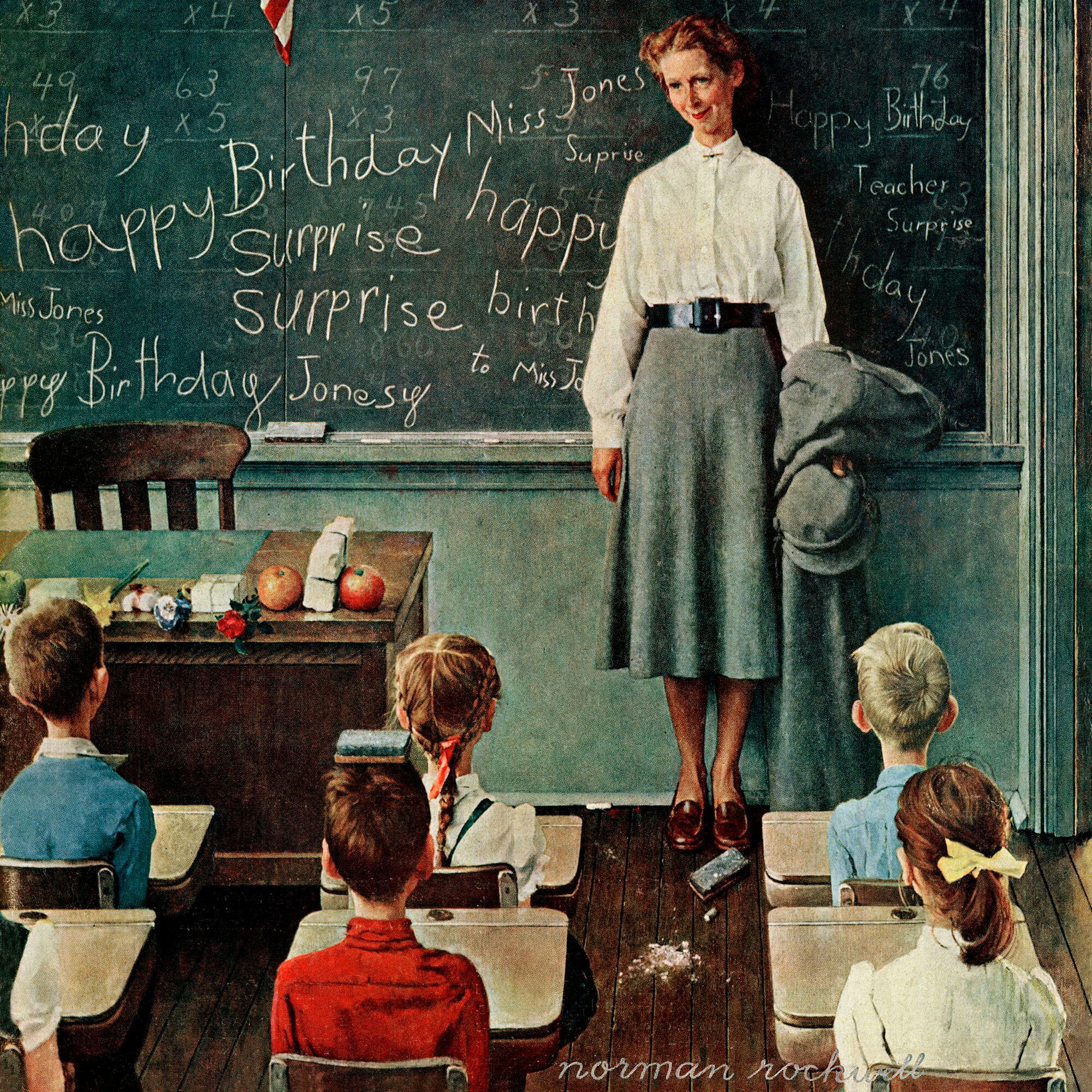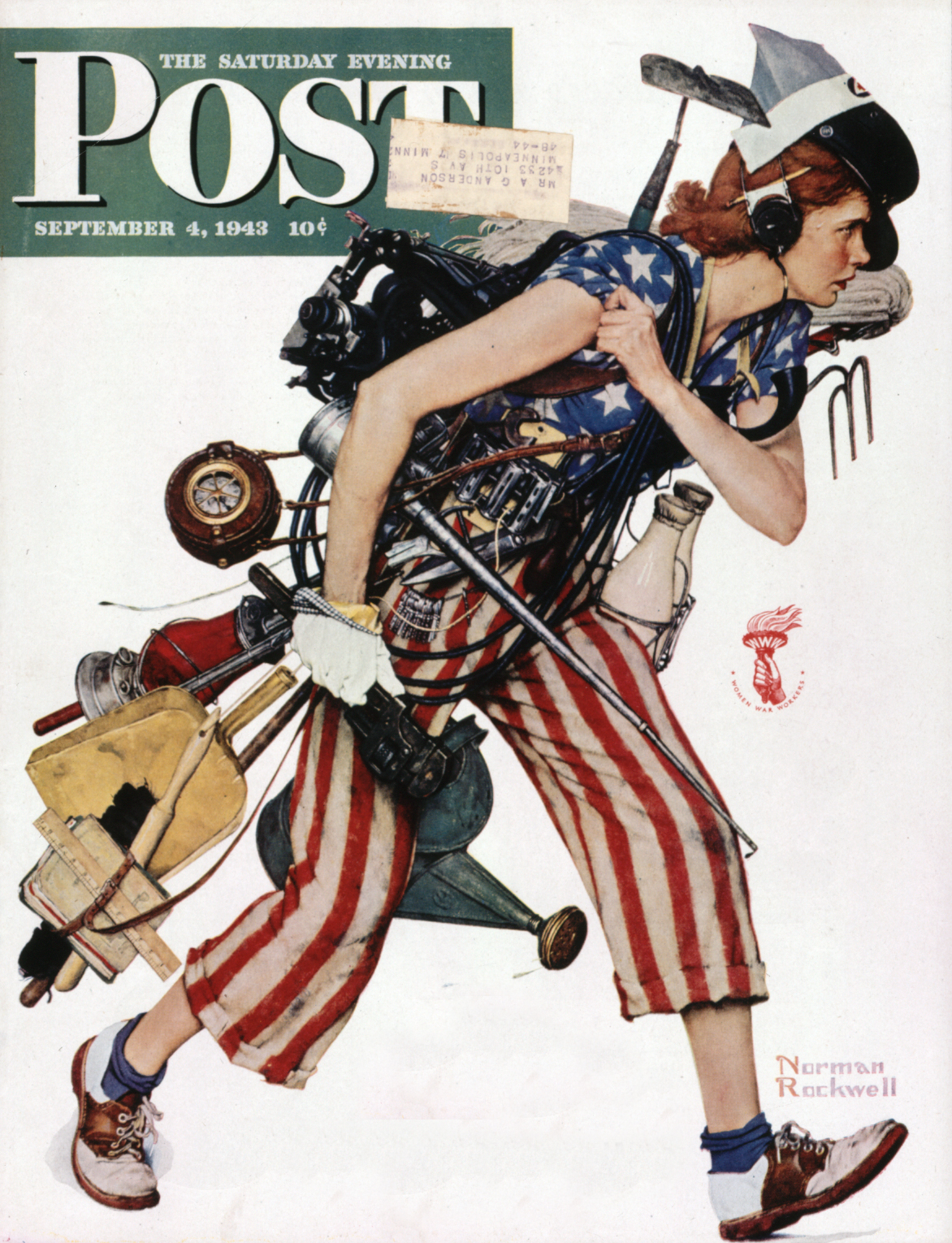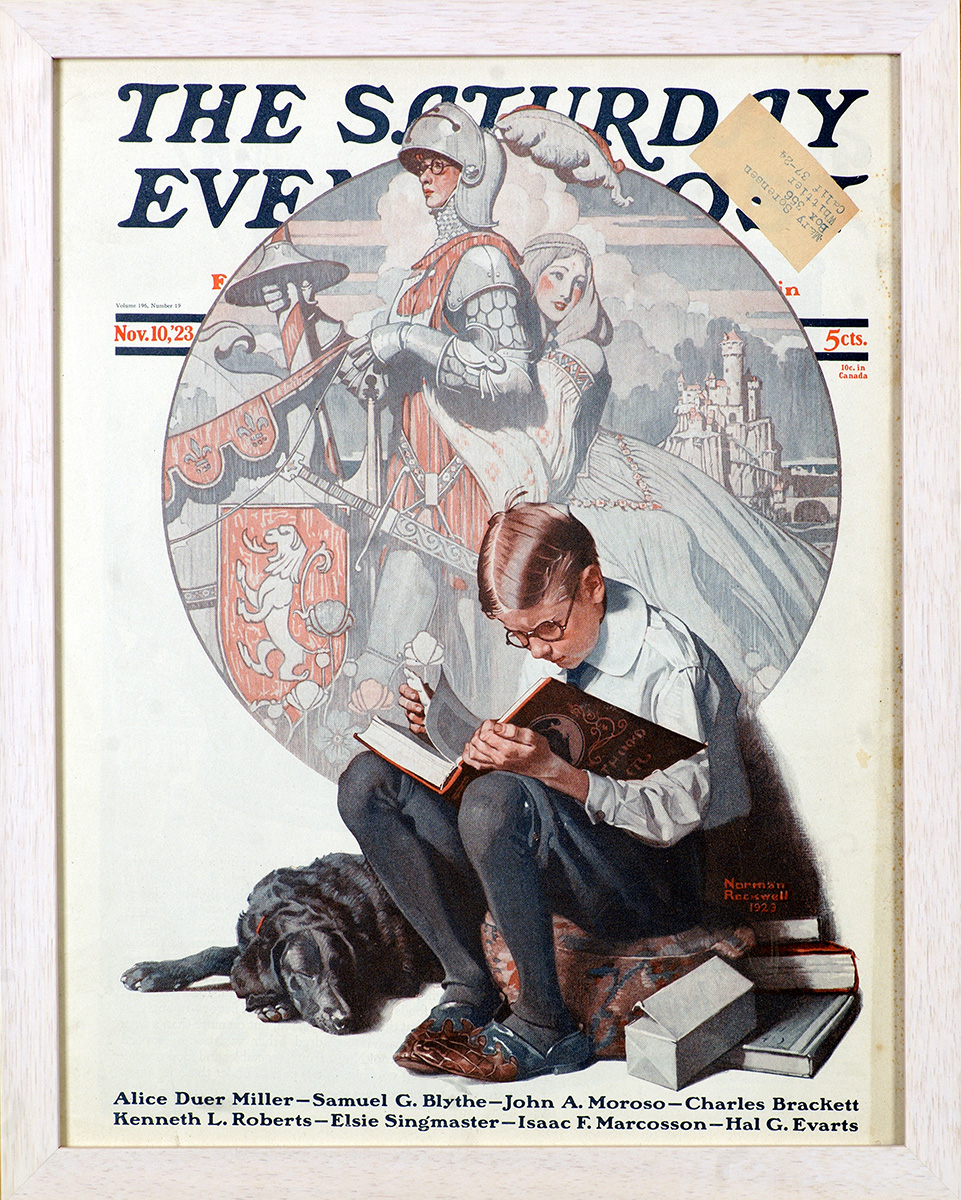Quick Pics: Heroes - Week of 4/13/2020
Overview - Heroes
We are surrounded by ordinary people who are giving themselves to serve others: bus drivers, delivery people, airline workers, grocery store clerks, post office workers, line cooks, police officers, food producers, social workers, janitorial staff, tradespeople, teachers, child care providers, farm workers, utility maintenance professionals, health care workers, servicemen and women, nurses, doctors. Their dedication deserves our profound thanks. It also proves that the great strength of America remains where it has always been: in ordinary Americans, setting their shoulders to accomplish the task before them.
- Heather Cox Richardson April 6, 2020
Norman Rockwell Visits A Family Doctor (1947)
We are exploring what it means to be a hero, and we are celebrating the heroes we know. We chose the image Norman Rockwell Visits a Family Doctor in recognition of all the doctors, nurses, paremedics and EMTs who work in all kinds of conditions, without fanfare, and doing lifesaving work.
Notice...
- Rockwell shows a close connection between Doctor Russell, the child he is caring for and the child’s family. Doctor Russell leans in and speaks warmly and directly to the mother and father, who hold a baby, his patient, in their lap.
- All eyes are focused on the doctor and family, including those of the dog on the chair and the little boy on the right side of the room.
- The things in the doctor’s office tell a lot about him, just as the things in our spaces say alot about us.
- Notice the photo of the woman in uniform is actually Dr. Russell’s daughter, a nurse in the US Army during World War II, which ended just a couple of years before this painting appeared in The Saturday Evening Post magazine.
- Dr. Russell’s office was in his home, both in real life and in this painting.
- Look on the right hand side of the picture at the unusual contraption near the window. It was an electronic device that helped the doctor remove warts from people’s bodies.
Wonder...
- Does this doctor’s office look the same as the one you visit? What is the same and what is different?
- And look at the things on the wall - does your doctor’s office have a deer head and a rifle on display? A machine for removing warts?
- Every detail was placed in the picture by Rockwell to help him tell his story.
Fun Facts!
- Doctor Russell, pictured here, was actually Norman Rockwell’s own physician in Arlington, Vermont, and he took care of Rockwell’s wife Mary and three sons, too.
- Norman Rockwell asked Dr. Russell to clean up his office in preparation for painting it.
- Bozo the dog was Dr. Russell’s dog and he spent many of his days in Dr. Russell’s office seeing patients. Rockwell received letters from people who thought there should not be a dog in the office. Rockwell wrote back and reassured readers that Bozo caused no harm and belonged right where he is pictured.
What you can do!
- Help doctors and nurses health care providers now by maintaining social distancing and hand washing. Wear a mask where it is called for.
- Write a note to your newspaper thanking doctors and nurses and first responders for their work.
Mine America’s Coal (1944)
We chose this image to celebrate all Americans working in essential services. Essential services include men and women in healthcare, grocery and food production, transportation and public works. The Easter bunny and tooth fairy are also essential service workers according to the Prime Minister of New Zealand. We agree with her.
Mine America’s Coal, set in the 1940’s, invites us to, think about the values of sacrifice, bravery, service, and family.
Notice...
- The man’s expression.
- His face and clothing are smudged with dirt,
- Notice the helmet and lamp on his head.
- Notice the stars on his shirt.
- The details in the art invite us to understand a story which is bigger than the picture itself about the heroism of the miner and his family, and everyone who works to help others.
Wonder...
- What do you think the coal miner’s smile tells us about the way that he feels about the work that he does?
- Why would a helmet and lamp be important for working in a mine?
- What do the stars on his shirt mean?
Fun Facts!
- This man has very likely worked as a miner, digging coal from deep in the earth, for his whole life.
- During World War II in the 1940s, coal was a very important raw material in America, because it powered locomotives and was used to produce iron, steel, and electricity.
- In 1944, this portrait by Norman Rockwell appeared on a poster that encouraged workers to produce more coal to help soldiers do their jobs.
- The pin with two stars on the miner’s overalls represents the fact that he had two children enlisted in the armed forces who were fighting during World War II to protect others.
What you can do!
- Think about the heroes in your community who are not always in plain sight, but who make significant contributions.
- Draw a hero who has helped you - is it a family member, a teacher, a friend, or someone else?
Happy Birthday Miss Jones (1956)
We chose this painting to recognize all the heroic teachers and students focused on learning and community. In person and online, teachers and students are adaptive, creative and taking care of each other.
Notice...
- Students are heroes for noticing their teacher’s birthday, and for creating a party with the simple things available to them.
- Ms Jones, the teacher, is a hero for creating a classroom community where students notice and find ways to celebrate important moments including birthdays!
- Thoughtful and creative students in this class have made a party for the teacher they care about by writing messages on the black board and bringing simple but lovely gifts.
- There is an orange, apples, a few brightly colored flowers, and packages wrapped in plain white paper, ribbon, and string.
- Can you find the student with an eraser on his head?
- Look at the expression on the teacher’s face - how do you think she is feeling about all of this?
Wonder...
- Will this painting inspire you to notice each other’s special gifts and contributions? How can you be the helpers in your class and community?
- How has your class developed independence and acted in creative ways?
- How do you share your care for each other?
- Does it suprise you that there is a student with an erasor on his head? Why or why not?
Fun Fact!
- The inspiration for this painting was Miss Julia M. Smith, Norman Rockwell’s favorite elementary school teacher, who recognized his artistic talent and let him draw pictures on the blackboard. Rockwell wrote a note to Miss Smith years later to let her know how much she meant to him.
What you can do!
- Let somebody you care about know how much they mean to you. Find a creative way to support their learning interests.
Liberty Girl (1943)
We chose the painting Liberty Girl which Rockwell painted in 1943 because she is a special kind of hero among us. She looks unafraid, has tools, leans forward and strides towards her next project. She takes care of what needs to be done and also makes a fashion statement.
Notice...
- The liberty girl is leaning forward, she strides confidently,and she has biceps. She is so strong.
- Notice all the different tools she carries.
Wonder...
- Which tools do you recognize? What objects are unfamiliar?
- Think about all the tools you use in a day. If you carried them all at once would you look like the liberty girl? How would your tools look different from hers? How would they look the same?
Fun Fact!
- The model for this painting did not have stars and stripes on her clothing. Rockwell added them to make her look like she was wearing an American Flag and to show patriotism. The saddle shoes were a fashion statement of the day, and socks falling down show how determined she is. She doesn’t stop to pull up her socks.
What you can do!
- Think about all the ways you’ve been creative and learned new things in the last few weeks. Talk in your class or household and make a plan about what you will learn next.
Boy Reading Adventure Stories (1923)
Reading is a portal to adventures and learning about heroes from history and the current times. There is so much to learn even as we stay close to home.
Notice...
- The boy is with his patient dog, wearing his cozy slippers, reading a story about a heroic knight that springs right from the pages of his book. He has lots more books to look forward to and is settled in for a long reading session with a snack.
- Eating while reading in 1923 would likely be considered as indulgent so it is a clue that this boy is engrossed in his story.
- As a boy, Rockwell would listen to the classic stories read after dinner by his father, and he tried to imagine what the characters and settings would look like by drawing them.
Wonder...
- Do you think Norman Rockwell’s experience being read to might have inspired this painting? Have you ever imagined you were a character in a book?
Fun Fact!
- The boy is reading about knights and castles and he is THE KNIGHT in his imagination. This is why books can be more fun than movies! The boy’s cowlick connects him to himself as a knight wiht a helmet and feather plume.
- Rockwell was only 29 years old when he painted this image. He loved being read to as a boy and we can imagine his own experience inspired him.
What you can do!
Find or create the cozy place to read in your house now. Read about a hero. What did you learn from them?
Share a favorite book or story with a friend. Create a drawing from your imagination illustrating a hero from a favorite book.
Image Resources
Norman Rockwell Visits a Family Doctor (1947)
Mine America's Coal (1944)
Happy Birthday Miss Jones (1956)
Liberty Girl (1943)
Boy Reading Adventure Stories (1923)
Image Credits:
Norman Rockwell Visits a Family Doctor, 1947
Norman Rockwell (1894 - 1978)
Oil on canvas
Story illustration for The Saturday Evening Post, April 12, 1947
Norman Rockwell Museum Collection
© 1947 SEPS Curtis Licensing, Indianapolis, IN.
Mine America's Coal, 1944
Norman Rockwell (1894 - 1978)
Oil on canvas
Illustration for the U.S. Office of War Information poster
Norman Rockwell Museum Collection
© 1944 Norman Rockwell Family Agency
Happy Birthday Miss Jones, 1956
Norman Rockwell (1894 - 1978)
Oil on canvas
Cover illustration for The Saturday Evening Post, March 17, 1956.
© 1956 SEPS: Curtis Licensing, Indianapolis, IN
Liberty Girl, 1943
Norman Rockwell (1894 - 1978)
Cover Tear Sheet (edited)
Cover illustration for The Saturday Evening Post, September 4, 1943.
© 1943 SEPS: Curtis Licensing, Indianapolis, IN
Boy Reading Adventure Story, 1923
Norman Rockwell (1894 - 1978)
Cover Tear Sheet
Cover illustration for The Saturday Evening Post, November 10, 1923.
- Grade
- K-6
- Theme
- Quick Pics
- Length
- Each Quick Pic activity is about 5-10 minutes in duration, with each being taught one image per day over a week.
- Discipline
- Social Studies, Language Arts: Speaking and Listening, Art
- Vocabulary
- Hero; Heroes, Doctors, Workers, Teachers, All of Us
Standards
This curriculum meets the standards listed below. Look for more details on these standards please visit: ELA and Math Standards, Social Studies Standards, Visual Arts Standards.
- CCSS.ELA-Literacy.CCRA.L.1
- Demonstrate command of the conventions of standard English grammar and usage when writing or speaking.
- CCSS.ELA-Literacy.CCRA.L.2
- Demonstrate command of the conventions of standard English capitalization, punctuation, and spelling when writing.
- CCSS.ELA-Literacy.CCRA.L.3
- Apply knowledge of language to understand how language functions in different contexts, to make effective choices for meaning or style, and to comprehend more fully when reading or listening.
- CCSS.ELA-Literacy.CCRA.L.4
- Determine or clarify the meaning of unknown and multiple-meaning words and phrases by using context clues, analyzing meaningful word parts, and consulting general and specialized reference materials, as appropriate.
- CCSS.ELA-Literacy.CCRA.L.5
- Demonstrate understanding of figurative language, word relationships, and nuances in word meanings.
- CCSS.ELA-Literacy.CCRA.L.6
- Acquire and use accurately a range of general academic and domain-specific words and phrases sufficient for reading, writing, speaking, and listening at the college and career readiness level; demonstrate independence in gathering vocabulary knowledge when encountering an unknown term important to comprehension or expression.
- CCSS.ELA-Literacy.CCRA.SL.1
- Prepare for and participate effectively in a range of conversations and collaborations with diverse partners, building on others' ideas and expressing their own clearly and persuasively.
- CCSS.ELA-Literacy.CCRA.SL.2
- Integrate and evaluate information presented in diverse media and formats, including visually, quantitatively, and orally.
- CCSS.ELA-Literacy.CCRA.SL.3
- Evaluate a speaker's point of view, reasoning, and use of evidence and rhetoric.
- CCSS.ELA-Literacy.CCRA.SL.4
- Present information, findings, and supporting evidence such that listeners can follow the line of reasoning and the organization, development, and style are appropriate to task, purpose, and audience.
- CCSS.ELA-Literacy.CCRA.SL.5
- Make strategic use of digital media and visual displays of data to express information and enhance understanding of presentations.
- CCSS.ELA-Literacy.CCRA.SL.6
- Adapt speech to a variety of contexts and communicative tasks, demonstrating command of formal English when indicated or appropriate.




